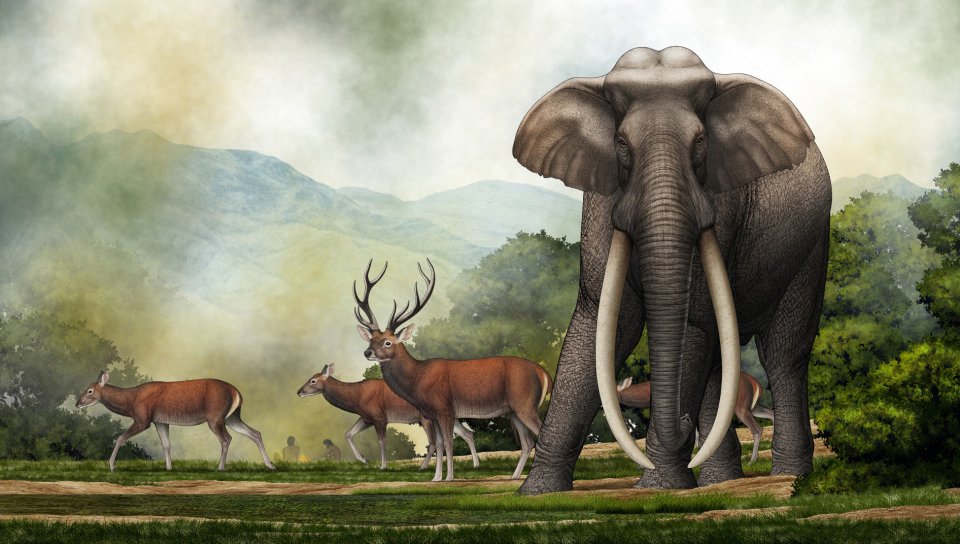Ancient giant elephant graveyard proves colossal creatures were REAL and roamed Earth 300,000 years ago, say scientists
AN ANCIENT elephant graveyard has revealed that the colossal creatures roamed Earth 300,000-years-ago.
Scientists have discovered the remains of one of the largest mammals to ever walk the Earth at a quarry in Pampore, India.
A giant skull from a straight-tusked elephant known as Palaeoloxodon was dug out from the quarry in 2000, followed by a cache of fossils and stone tools used by ancient humans.
At the time, researchers were able to determine that the death of the colossal beast occurred 300,000-years-ago after breaks in the skull have scientists a rare chance to look inside.
Scientists were able to determine that the giant elephant was sick at the time of its death.
Dr Simon Parfitt, a human evolution researcher at the Natural History Museum said: “When we peered into the damaged section, we could see that something was odd about the inside of the skull.
Read more science news
“Elephant skulls are full of air spaces to make the head lighter, but the bone along the sinus cavities had grown in an abnormal, spongy structure.
“We believe this indicates the individual was suffering from sinusitis, possibly due to an infection spreading from another part of the body or from a severe respiratory disease.
“Either way, it may have contributed to its death.”
However, the presence of stone tools and broken elephant bones found in the quarry suggested that humans might have had something to do with the beasts death.
Now scientists from across the globe have come together to piece together the earliest evidence of human’s eating elephants.
According to a study in the Journal of Vertebrate Palaeontology, humans were feasting on the mammoth-sized creatures between 300,000-400,000 years ago.
Giant 10ft sloths, camels taller than humans and 150lb cheetahs – the fearsome ancient beasts that roamed ancient USA
Dr Parfitt said it offered new insights after skeletal fragments found at the site suggested that ancient humans were smashing the bones with heavy rocks to get to the nutritious marrow inside.
He said: “Discoveries like these have brought the region to the attention of archaeologists, who are now looking more closely for new butchery sites.
“Given the size of these animals, and the relatively small size of human groups, it’s unlikely they would have been able to fully butcher this elephant before it started to rot.
“This means they probably went for the prime cuts of meat rather than stripping the carcass, so there’s much less chance of any marks being left behind on the bone.”
It comes after a perfectly preserved sabre-toothed tiger cub was discovered frozen deep in Siberian ice.
The extinct beast was found complete with its fur and sharp claws intact as the remarkable discovery is believed to be over 35,000 years old.
The pristine remains of the three-week-old kitten were first found in 2020 in the Russian Republic of Sakha, along the Badyarikha River.
Its entire head and the front side of its upper body was discovered completely enclosed inside a block of ice, according to a paper published in Scientific Reports.
Incredible images show the cub’s furry head with even its whiskers still pointing proudly out from under its nose.
Radiocarbon dating suggests the mummified big cat is from the Late Pleistocene period.
Frozen remains of mammals from around this time are said to be “very rare,” the researchers claim.
The kitten’s paws, including its pads and claws were all found well preserved on the front paws with the claws said to be sharp and strongly curved.
Six pairs of ribs were also visible with further fragments indicating at least 12 pairs existed.
Meanwhile, the world’s tiniest dinosaur egg from a whopping 80 million years ago has also been discovered “perfectly preserved”.
The miraculous find dates all the way back to the Late Cretacerous period and offers unbelievable insights into the reproductive habits of dinosaurs.
Six near-perfect egg fossils were gouged from a well-preserved nest bizarrely found at a construction site in Ganzhou, China – with them being just the size of a 50p.
Another ancient discovery saw miners stumble upon a preserved woolly rhino which experts hope to bring back to life.
Read More on The US Sun
The magnificent 10,000-year-old beast was found by gobsmacked workers while digging for gold.
There are also hopes of bringing such extinct animals – including woolly mammoths – back to life by using DNA found on such carcasses preserved in the ice.
Note: Thank you for visiting our website! We strive to keep you informed with the latest updates based on expected timelines, although please note that we are not affiliated with any official bodies. Our team is committed to ensuring accuracy and transparency in our reporting, verifying all information before publication. We aim to bring you reliable news, and if you have any questions or concerns about our content, feel free to reach out to us via email. We appreciate your trust and support!















